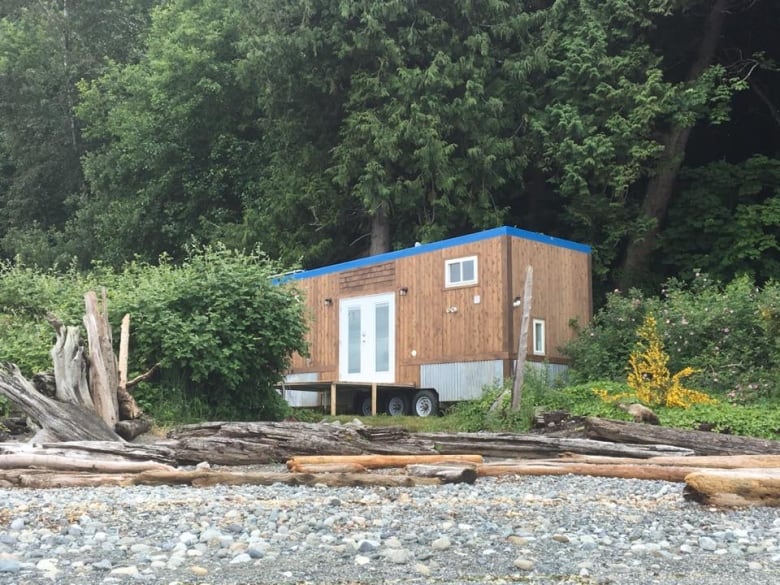Tiny house on the run: Couple's journey to find a home for their home hits dead end
‘We are trying to do everything legally on the up-and-up and I feel like a criminal’

Vancouver Island couple Robin and Jenn Sheffield traded their full-sized house in Mill Bay, just north of Victoria, for a 280-square-foot option, only to face rejection everywhere they tried to park their alternative dream home.
The couple are part of a minimalist movement, convinced cheap, energy-efficient mini-homes can solve Canada's housing crisis, but most B.C. municipalities aren't ready — or zoned — to welcome them.
"It's tough being a pioneer, but hopefully some of the heartache that we are going through will change some of the legislation," said Robin Sheffield, 35.
"We're hoping tiny homes become more accepted."
The Sheffields first tried to buy a plot of land, but that fell through because the municipality refused to accept their tiny house was a real house. Then the couple tried to park their new, custom built home at a Vancouver Island recreational vehicle park this month and again were rejected, this time because the rig did not meet park standards.
Today, the Sheffields are still looking for a spot to legally park their mini dream home.
This couple's plight highlights a flaw in the tiny home dream.

While Tiny Home Alliance Canada estimates hundreds of people are ditching monster mortgages for homes on wheels, ranging in size from 200-square-feet up to 700-square-feet, largely inspired by cable shows that tout 'tiny' living, they often run up against zoning rules and building standards.
A Vancouver couple faced a similar dilemma earlier in June when neighbour complaints forced them to move their wood-sided home.
But despite their low cost, tiny houses have not taken off in part because municipal zoning regulations aren't set up to handle the small dwellings. For example, the tiny homes don't hook into city systems such as sewer or power. The Sheffield house has a composting toilet and uses solar panels for power.
B.C. lawyer Troy DeSouza, a municipal law expert, says cities are only trying to protect people from building code blunders like the leaky condo crisis. As a result, the miniature homes are not welcomed by all.
Mansion dwellers, for example, don't want "a little old lady living in a shoe" on their street, said DeSouza.

Location, location, location
The top B.C. builders are aware of these zoning constraints. So before they design a tiny home, they ask would-be owners where it will be located — and attempt to build it to fit the local rules. Many actually certify the tiny home as a recreational vehicle.
This enables easier financing because banks struggle to classify the structures. But there are a host of moving and insurance issues.

"We didn't think it would be this difficult," said Sheffield. "They don't tell you about this stuff on H.G.T.V."
Going tiny
The Sheffields downsized because they were only using 200-square feet of their 2,200-square-foot home.
They chose an Alberta builder and spent $110,000 for a 280-square-foot-model.
To their dismay, the couple's original plan to put it on a plot of land in Langford, B.C. was rejected. They faced similar restrictions in all 13 nearby municipalities and wound up booking into the Beachcomber R.V. Park in Central Saanich.
But even that soured when they were chased off the property by an angry employee screaming, "Nobody wants you here."
Staff at the Beachcomber park told CBC the tiny house failed to meet the ocean-front park's standards, in part because it lacked a self-contained holding tank for sewage and grey-water waste.
"We regret the situation that developed with the owners of this tiny house. We would certainly handle it differently in the future," staff wrote in an email.
No tiny regrets
Now the tiny house — brand new sewage tank installed — is parked in a friend's driveway north of Victoria while the Sheffields hunt for land.
"It's funny because we are trying to do everything legally on the up and up and I feel like a criminal," said Robin Sheffield.
"We have to make room for alternative living styles. But right now municipalities are not open to it."
The Sheffields never expected to live in a tiny house — on the run.
But they don't regret "going tiny."
"Despite all the heartache we love our little house," Robin Sheffield said. "All we need is a place to put it."



